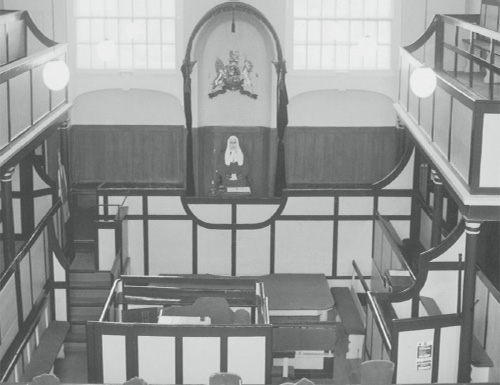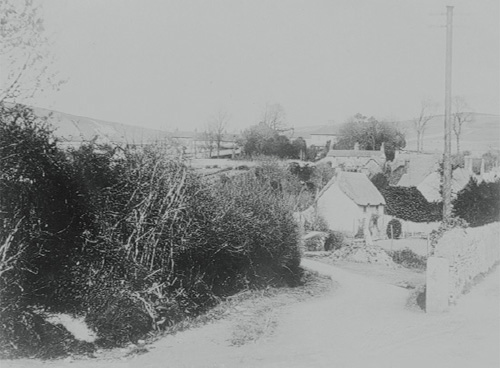Dorset Murders (4 page)
T
his is the account of the murder of Sarah Guppy. Sarah and her mother lodged with a man named James Seal and, by coincidence, the man suspected of murdering her was also called James Seal, although the two men were not related. The accused will be referred to as Jim Seal to differentiate between the two men.
Sarah Ann Guppy lived at Buckshorn House, which was situated in an isolated valley approximately one third of a mile from the village of Stoke Abbott, near Beaminster. The cottage was divided into two halves. John Hutchins, the owner, lived in one part with his wife and family, while a widower named James Seal lived in the other, with Sarah and her mother, Rebecca, as his lodgers. Although Sarah was illegitimate, she was âof good and chaste character'. Unfortunately, twenty-three-year-old Sarah was also rather weak and sickly, with some deformities to her back and neck.
Since she was not a very robust young lady, she wasn't fit enough to work like the rest of her family and neighbours, who all laboured in the fields for local farmers. Therefore, on 30 April 1858, Sarah was at home alone, as she usually was, doing the housework and preparing supper.
In the middle of the afternoon, Jane Cornick, who was then more than seventy years old, walked down the lane to her garden, which was next to the cottage where Sarah spent most of her days by herself. While there, Jane Cornick heard a loud screech coming from Sarah's cottage. Knowing that Sarah would be alone, Jane scrambled up the bank surrounding her garden and peered over the hedge, calling Sarah's name several times as she did so.
She received no reply but as she watched, a young man called Jim Seal emerged from the door of Sarah's cottage. As he left the cottage, Seal ducked down as though he wanted to avoid being seen. However, as he crept away he spotted Jane Cornick standing on the bank, and turned to approach her.
Jane asked him what he had been up to to make Sarah scream â had he been âmaking work' with her? Jim replied that he had been doing nothing of the sort, adding that he had left Sarah peeling potatoes for supper. Cornick noticed that his hands were bloody and that he had some blood on his trousers. She asked him what was wrong with his hands and was told that he had cut his finger on some grass. âIf grass would cut your hands, I should be cutting mine all day long, pulling up as much grass as I do', remarked Jane, giving him some paper from her pocket to wipe away the blood. She then walked with Jim for about 400 yards towards the village of Stoke Abbott before the two parted and went their separate ways. Jane went to visit her son but Jim Seal apparently had unfinished business with Sarah Guppy.
At about 4 p.m., people working nearby noticed smoke billowing from Buckshorn House and raised the alarm. On hearing that his home was on fire, James Seal ran from the fields. As soon as he entered the cottage, he saw Sarah lying on the floor with something covering her face. Shouting at her to get up and get out, Seal raced upstairs to try and save a few personal items from the flames. Only when he came downstairs again and saw Sarah still lying there did he realised that something was seriously wrong. With the help of his neighbours, he carried Sarah out to the small orchard adjoining the cottage and laid her on the grass. Once outside, in daylight, it was obvious that the poor girl's throat had been cut from ear to ear.
Meanwhile, Jane Cornick had heard about the fire and retraced her steps to Buckshorn House, arriving approximately three-quarters of an hour after she had previously left it in the company of Jim Seal. By that time, the cottage was almost completely destroyed by the fire, which had apparently started in an adjoining outbuilding. It seemed obvious that the killer of Sarah Guppy had deliberately set the fire in the hope that the evidence of his handiwork might be consumed in the flames.
The police were informed that a murder had been committed and PC William Lavender set out to investigate. However, by 5 p.m. he had got only as far as Horsehill when he was stopped by a local shepherd who told him that the man suspected of being the murderer had passed by only moments earlier. PC Lavender went after him and soon caught up with Jim Seal.
He noticed a bit of rag wrapped around Seal's right forefinger, covering a fresh wound. He also saw what looked like spots of blood on Jim's trousers. The bloodstains looked quite bright, although some had obviously been rubbed with dirt to disguise them. Jim also had blood on the right sleeve of his jacket, while the left sleeve had a large burn mark.
Lavender asked Jim how he had come by the cut on his finger and was told that he had gashed it with a knife while trying to cut a stick at nearby Bowood. When Lavender asked where the knife was, Jim explained that he had borrowed it from a carter and then returned it. He claimed that he didn't know the carter's name, nor could he describe him, or even say how many horses he was driving. Next Lavender asked where the stick was but Jim told him that he had not actually cut one, since he had cut his finger.
Had Jim been anywhere near Buckshorn House that afternoon, asked Lavender. Jim swore that he had been to Honeycomb and Bowood to pick up some sticks, but he had no sticks with him at the time. Lavender warned him that, if he could not come up with a better explanation for the bloodstains on his clothing, then he would be arrested on a charge of murder. No better explanation was forthcoming and Jim Seal was duly taken into custody.
At the inquest into Sarah's death, the jury came to the conclusion that she âwas by Jim Seal feloniously, wilfully and with malice aforethought killed and murdered'. Seal was quickly brought before magistrates, who committed him for trial at the next Dorset Assizes.
At his trial Jim Seal changed his story. Now he maintained that he had been working at Broadwindsor on the day of the murder and had been paid for his labour with two quarts of cider. After drinking these, he claimed that he recalled very little. However, witnesses were called who remembered him working at Stoke Abbott on that day, less than a quarter of a mile from Sarah's home, and stated that when he left work there were no bloodstains on his clothes and no cut on his finger.
Noah Hussey, who lived next door to Jim Seal, testified to seeing Jim eating bread and cheese with a very pointed knife, similar in appearance to one of three found in the cottage, near to where Sarah's body had lain. Another witness, Mr Paul, told the court that he had watched Jim Seal rubbing yellowish dirt on his trousers at about 4.30 p.m. in a field on the afternoon of the murder.

The courtroom at Dorchester, 2008. (
©
R. Sly)
Jane Cornick gave evidence about what she had seen while visiting her garden on the day of the murder, telling the jury of hearing Sarah scream just once, in apparent terror, and telling the court, âI fancied it was a sort of deathly scream'. When she left the cottage with Jim Seal there had been no signs of a fire, suggesting that Seal had returned and started the blaze in an effort to conceal the murder.
A key to the Hutchins's side of the cottage was found just outside the door to Sarah's home and it was widely known that Mrs Hutchins had given Sarah a key for safekeeping. Jim Seal had been a frequent visitor to the Hutchins's home, usually trying to scrounge money. However, shortly before the murder there had been an âincident' and Mrs Hutchins had told Jim Seal never to come again. According to Rebecca Guppy, Seal had been hanging round making a nuisance of himself for some time and Sarah herself was of the opinion that he was up to no good.
In summing up the case for the jury, the judge told them that it was difficult to suggest a motive for the crime, but reminded them that many a crime had been committed in the past without an apparent motive. It was not their duty to speculate on a possible motive, rather they should look at the facts of the case and, if they believed that the proven facts tied the accused to the case, then they should find him guilty. If they had any doubts then they should acquit him, but if they were completely satisfied that Jim Seal had committed the crime then it was their duty to God and man to find him guilty.
The jury duly discharged their duty, finding Jim Seal guilty of the wilful murder of Sarah Ann Guppy. Seal did not look like a man capable of so diabolical an act, looking much younger than his twenty years and standing only a fraction over 5ft tall. However, appearances can be deceptive and, in this case, they obviously were since Seal made a full confession just before his execution. He was hanged at Dorchester on 10 August 1858.
âIF YOU BIDE THERE CHAFING ME, I'LL GET UP AND BEAT THEE BRAINS OUT'


O
n 8 July 1862, former butcher John Cox of Preston near Dorchester received an important visitor. Cox, who lived in a small cottage with his elderly parents and two brothers, had for some time been suffering from a strange illness that manifested itself in fits and seizures that left him unable to work.
During the previous November, Cox had served a short prison sentence for poaching. In a routine check of the cells one morning, a prison officer had found him lying motionless on his bunk, as if dead. His eyes were open and staring, his whole body was extremely cold and he would not, or could not, respond to any outside stimuli. The warder immediately sent for the prison surgeon, who professed himself baffled at Cox's condition. He could do nothing more than order that the prisoner should be closely observed and any sign of change reported to him immediately.
Cox lay in a catatonic state for two more days before awakening, at which point he became so violent that he had to be forcibly restrained by strapping him to his bed. By now the surgeon was of the opinion that Cox was suffering from catalepsy, which was causing mania; a state that he felt could recur at any time if Cox were stressed or annoyed.
Released from prison into the care of his parents, Cox's condition worsened steadily as the months passed. His speech was rambling and by the following summer, according to the parish rector, Revd Baker, he was in such a state of confusion that it was impossible even to pray with him. Cox apparently believed that he was hearing the voice of God and that God was telling him that He had come to take him.

Preston village at the turn of the nineteenth century
.